Former South Pasadena High School Spelling Champion George Hodel Feigns Illiteracy as Part of his Black Dahlia Avenger, Lipstick, Zodiac Crime Signatures
June 21, 2017
Los Angeles, California
George Hodel 1923 South Pasadena Year Book
Los Angeles Daily Times June 5, 1923
In the early 1920s teenager, George Hodel attained the highest Public School test scores of any student in the State. Based on those results he became part of one of the most famous psychological testings of that day. George was selected to be one of the students included in Stanford professor, Dr. Lewis Terman’s “Genetic Studies of Genius.” The test students became colloquially known as “Terman’s Termites.” (Over the past 90 years, five separate books have been written on this study which had the students send in “progress reports” every five years during their lifetimes. GHH was still sending in his at age 85.)
Samples of George Hodel Feigning Illiteracy in Chicago Lipstick, Black Dahlia Avenger, and Zodiac Notes
“Get $2,000 Reddy & waite for word… Chicago Lipstick Killer (1946)
“To Hearld Express, Los Angels…” Black Dahlia Avenger (1947)
“…we went to gether …I went to investigaate…” LA Avenger (Gladys Kern, 1948)
“I first pulled themiddli wire…her lips twiched…” Zodiac (Cheri Jo Bates, Riverside, 1966)
” I am mildly cerous as to how much money you have on my head .” Zodiac, SF, 1969)
UPDATE: 6.21.17 9:00 p.m.
From Black Dahlia Avenger, Chapter 13: THE LAPD AND THE PRESS: THE AVENGER MAILINGS
…
January 29, 1947
The Examiner engaged questioned-document expert Clark Sellers, considered by most to be one of the nation’s leading forensic handwriting experts of the day, to review and analyze the hand printing on the postcards it had received from the purported suspect. Sellers had gained public notoriety as one of the chief forensic experts who testified for the prosecution in the Lindbergh baby kidnapping trial, in which he connected handwriting samples from the suspect, Bruno Richard Hauptmann, to the ransom note and helped the state win a conviction.
In his expert analysis, Sellers told the Examiner:
“It was evident the writer took great pains to disguise his or her personality by printing instead of writing the message and by endeavoring to appear illiterate. But the style and formation of the printed letters betrayed the writer as an educated person.”
The Examiner also revealed that Sellers had conducted “microscopic tests” on the Black Dahlia message and made “several important discoveries the nature of which is being withheld.”
A second questioned-document expert, Henry Silver, was also contacted to analyze the original note the killer had sent with the victim’s belongings, as well as some of the later postcards received by the press. Silver said:
The sender is an egomaniac and possibly a musician. The fluctuating base line of the writing reveals the writer to be affected by extreme fluctuations of mood, dropping to melancholy. The writer suffers from mental conflict growing out of resentment or hatred due to frustration of sex urge. Because the last letters of many words are larger, it reveals extreme frankness. The writer is telling the truth. Furthermore, he can’t keep his secret and feeds his ego by telling. There is a fine sense of rhythm present, showing the penman to be either a musician or possibly a dancer. He is calculating and methodical.
In my 2003 investigation I hired my own independent court-certified Questioned Document Expert, Ms. Hanna McFarland, who conducted her own handwriting analysis and confirmed in her expert opinion that at least four of the handwritten notes were authored by George Hodel. She also examined an original handwritten sample of my father’s writing in my possession and opined:
“…It appears that all three handprinted letters (TEV, in the handwritten word STEVE) were highly connected, this is unheard of, and would indicate the type of exceptionally high intelligence and forethought that might be found in a master chess champion such as a Boris Spassky or a Bobby Fischer.”
GHH handprinted STEVEN showing the TEV connection as described by QDE Hanna McFarland.
Comment from LW re. Zodiac “Red Phantom” Letter mailed to San Francisco Chronicle on July 8, 1974:
Steve: Despite the zany spellings and wackiness of the Zodiac missives, the “Red Phantom” note implies the killer was in fact perfectly literate, possessing an artistic hand, a musical sense of rhythm and cadence, and the easy authority of a physician dashing off a script. The Phantom’s focus on SF Chronicle sex columnist Count Marco, a dandy and faux European aristocrat with links to 1940s Hollywood, offers yet another “clew” as to the Zodiac’s real identity. -LW
Below is a copy of that letter which I do believe was written by GHH and mailed some six years after the first SF Bay Area Zodiac crime was committed in the summer of ’68. In my sequel BDA II I make the comparison (below) to the unusual letter ‘h’ seen in the 1948 BD Avenger Glady’s Kern Note which appears identical to the “h” letters in the Red Phantom Note some twenty-six years later.
Author Prepared Zodiac Lexicon of Misspelled & Unusual Words
(From 24 Zodiac letters over twenty years – 1969-1990)
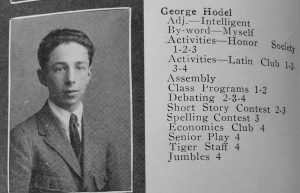
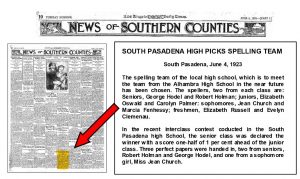
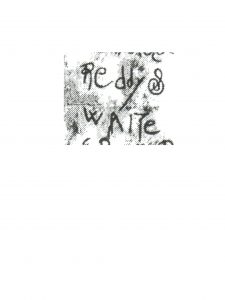
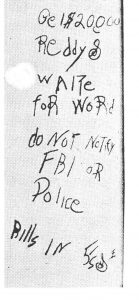
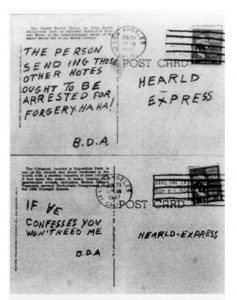
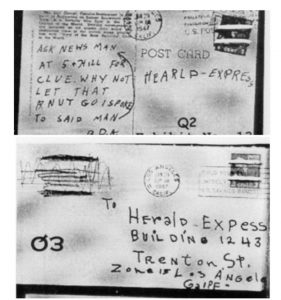
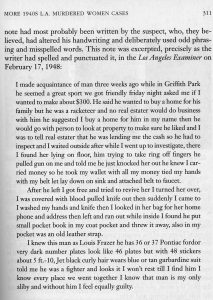
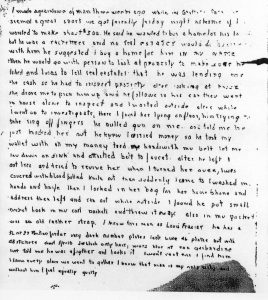
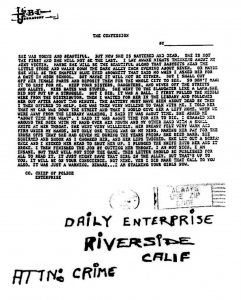
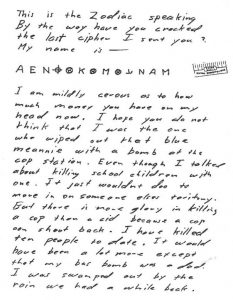
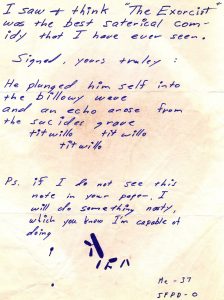
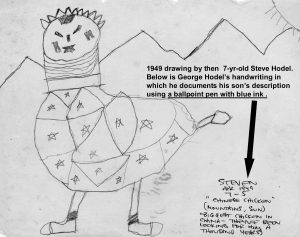
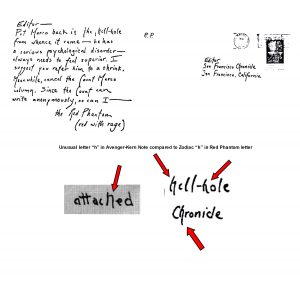
Steve: Despite the zany spellings and wackiness of the Zodiac missives, the “Red Phantom” note implies the killer was in fact perfectly literate, possessing an artistic hand, a musical sense of rhythm and cadence, and the easy authority of a physician dashing off a script. The Phantom’s focus on SF Chronicle sex columnist Count Marco, a dandy and faux European aristocrat with links to 1940s Hollywood, offers yet another “clew” as to the Zodiac’s real identity. -LW
LW: Agreed. And thanks for pointing out the 1923
LAT article mentioning GHH perfect score in the HS spelling contests. I’d missed that article.
Steve: You have pointed out that the idea for the misspellings appears to have been appropriated from the JtR case, along with certain other crime signatures (the dripping pen, the severed ear). I see the first book-length treatment of the case came out in 1929 — Leonard Matters’ “The Mystery of Jack the Ripper: The World’s Greatest Crime Problem.” Alfred Hitchcock’s “The Lodger,” featuring a JtR-like murderer who calls himself the “Avenger,” was released in the US in 1928. Matters’ book apparently covers the case including the purported Ripper letters in some depth and detail. Matters’ claimed JtR was a physician on a revenge trip. Today his story of an obscure deathbed confession to this effect is generally dismissed as a fabrication. I’m wondering if you’ve had a chance to read Matters’ book. Might there be a giveaway in there that it was an inspiration? -LW
LW: Thanks. Was unaware of the book, as I’ve never really got stuck into the JtR lore. Just superficially noting the various links. Will try to find and check it out. The timing in ’29 is perfect though. I think GHH was at his most impressionable stage and had already committed a number of crimes. I’ll see if I can find a copy. SKH
L.W.
P.S. Found a copy (1964 reprint) and ordered from the U.K. so should have it in a week or so. Thanks again. skh
L.W. P.P.S. Just rewatched Hitchcock’s 1948 film, ROPE starring James Stewart, John Dall, and Farley Granger. The film adapted from Patrick Hamilton’s 1929 play, which I want to order and read in its original, as changes were obviously made to the film adaptation. Hamilton obviously based his play on the Leopold and Loeb “Crime of the Century” from that time period, which occurred in May 1924. (GHH would have covered it for the LA Record as a young crime reporter.) This fits right in with GHH’s thinking of that day. GHH the elitist who also saw himself as a Nietzsche super intellect, above the law, not bound to conform like other mere mortals. A lot of GHH speak in the film and I’m sure he would have read the play back in ’29 and probably saw a performance of the play whenever it opened in the U.S. from the U.K.
Steve: The choice lines from ROPE (e.g., “the Davids of this world merely occupy space”) are completely “on the nose” and mesh with the Zodiac’s use of “As Some Day it May Happen” from THE MIKADO. I wonder if the infamous glasses found at the Leopold & Loeb crime scene suggested “fake clews” left at GHH crime scenes. The story of the 1920s Nietzschean thrill killers has been retold in COMPULSION (1959) and SWOON (1992). Leopold & Loeb’s notoriety inspired William Hickman (“The Fox”), GHH’s exact contemporary. His grisly 1928 murder of Marion Parker looks like a model for the 1946 murder of Suzanne Degnan. Hickman’s egoistic posturing sent a young Ayn Rand (recently arrived in Hollywood from Russia) into a bit of a swoon, as her critics are always eager to point out. -LW
LW: Yes, seen both Compulsion and Swoon and Orson Welles (Clarence Darrow) closing argument to the judge against capital punishment is still used in many law schools as one of the best summaries ever given. Was not aware of the Ayn Rand worship of Hickman’s Horrors. Interesting. skh
Steve: The parallels with Leopold and Loeb are striking. From well-to-do families, exceptionally intelligent, skipping grades to gain early admission to college then showing delinquent tendencies, obsessed with crime. Per Wikipedia, Loeb “spent most of his time reading detective novels,” while Leopold “was particularly fascinated by Friedrich Nietzsche’s concept of supermen.” GHH’s interest in crime went far beyond Dickie Loeb’s — as you show in BDA, he was poking around crime scenes as a kid reporter, riffling through murder victims’ personal effects, offering sly commentary on their tastes in art and home decoration, etc. Remy de Gourmont might have the Nietzsche role in the GHH story. This “aristocrat of letters” is hardly a household name today, but here’s how he was characterized in a 1922 article in THE NATION by Ben Ray Redman:
“The comparison of Remy de Gourmont and Friedrich Nietzsche is almost inevitable. The Frenchman is to the younger generation of today what the German was to the younger generation of yesterday: nearly an idol, a treasure-house, and an inspiration.”
Like Nietzsche, Gourmont’s worldview was highly individualist and elitist, derogating the “repressions” of traditional morality in favor of a radically subjectivist, naturalistic ethics. There’s a lot more sex in Gourmont’s philosophy, and it is ultimately more nihilistic than Nietzsche’s. GHH’s grandiose statements to the DA at the time of his incest arrest and the “nymphs and satyrs” theme running through his story (right up to his funeral arrangements) might have been inspired directly by Gourmont’s writing.
The following lines from MR. ANTIPHILOS, SATYR seem ironic in this context:
“You see my innocence. I protest, then, with all the strength of an honest, though libertine satyr, against the use of the term ‘satyr’ by your newspapers which apply it to men, — yes, to men, by Jupiter, who kidnap young girls, rip their bellies, slice them to pieces! A satyr would never do such idiotic things.”
Well, almost never!
Steve: In her writer’s notebook Rand asked: what if somebody with Hickman’s independence, daring and resourcefulness pursued rational, productive goals? An alternative what-if: what if a youth with those qualities but still criminalistically-inclined stayed one step ahead of the law and honed his game for another 40 or 50 years? GHH might be viewed as but one of a small crop of prodigy-psychopaths that emerged in the 1920s — the one that got away. -LW
Steve: Speaking of intelligent-and-charming homicidal maniacs conducting decades-spanning killing sprees, I wonder if you have seen THE JINX (2015)? I’d recommend it to anyone who thinks what you have claimed regarding GHH is simply too extraordinary to be true. Just watched the series and it certainly quelled my residual concerns on this score. -LW
No, haven’t seen it. But, on your recommendation, I jjust added to my Netflix queue and will watch it. Thanks. I’ve seen most of them, but that one slipped throught the “cracked mirrors” somehow. SKH
Steve:
Been perusing the 1924 edition of the “Big T” Caltech student annual. Looks like the 16yo GHH was quite active during his one year at the institute, before the big blow-up. He is listed as “Editorial Assistant” on the “Big T” and also as a reporter on the weekly “California Tech” newspaper. (Doesn’t look like the Tech editions from those years are available online.) He was on the Freshman Debating Squad. I suppose there’s an outside chance he ran into William Hickman on the high school or college debating circuit. No “smoking gun” references that I noticed, but some other points of interest:
1. According to the 1923 Caltech Bulletin, “Military Science and Tactics” was a requirement for freshmen. The year-long class encompassed fieldwork, marksmanship and demolition (thinking of the Zodiac’s ammonium nitrate fertilizer + “stove oil” bomb hoax).
2. There’s some stylistic resemblance between the scrapbook-like pages in the humor section at the back of the “Big T” and the two BDA “Robles” letters featuring pasted-on faces.
3. The traditions of “razzing” and the “razz sheet” might offer some precedent for GHH’s later mindset and exploits.
-LW
LW: Thanks for the info.
If my memory serves me correctly GHH got the job as a crime reporter (and one-time “Drama Critic”) for the LA RECORD in early 1924, and wrote the various articles in the summer of that year and left at year’s end. The letter of recommendation from the Burton Knies, Editor was written for GHH on 12.19.24
Steve: Looks like GHH probably completed his freshman year (Sep ’23 – May ’24) but did not return as a sophomore in the fall (based on the “Big T” for ’24 & ’25 and the Bulletin for ’23 and ’24). Perhaps the crime reporting job was originally to be for the vacation only. There might be articles with his byline in the weekly “California Tech” still out there to be found. -LW
Steve: The sensational “Crime of the Century” perpetrated by boy genius thrill-killers Leopold and Loeb occurred in May 1924, about the time GHH got the boot from Caltech and started the crime-reporting gig. Interesting timing. -LW
LW: Yep. “There are no coincidences” Harry Bosch
Steve:
In the Leopold & Loeb case investigators believed that one of the ransom letters was inspired by a story entitled THE KIDNAPING SYNDICATE. The piece appeared in the May 3, 1924 issue of DETECTIVE STORY MAGAZINE (favorite reading of philosopher Ludwig Wittgenstein, interestingly enough.) According to a detective on the case: “Look for the suspect with that magazine in his possession, and you’ll pretty nearly have the man that killed Bobby Franks” (ref: EVIL SUMMER, John Theodore).
Researchers have pinpointed a story entitled SIGNED “Z” from the August 27, 1921 issue of the same pulp magazine that might have influenced the future Zodiac. It features a killer with a grudge against banks whose MO is to phone the city desk at various newspapers to claim or predict his crimes and offer up cryptic clues. He sometimes calls from a pay phone near the scene of a murder. He systematically varies his method of killing (gun, knife, poison). He leaves calling card notes on red paper (bringing to mind the taunting crimson “razz sheets” GHH would have encountered as a freshman student/reporter at Caltech) signed with a “crude, gigantic letter Z.” Having read the story, I think its foreshadowing of the Zodiac crimes might well be a coincidence. On the other hand, the “vintage” is right…
-LW
Steve: Looks like the 16yo GHH responded to the double hit of the Folly debacle and getting kicked out of Caltech by designing his own major, one that soon had him on field trips to the murder scenes of Peggy Donovan (kicked to death) and Teresa Mors (shot in the face). Comparable to the story three decades later where GHH gets the Governor of Hawaii to make him ambassador plenipotentiary to the international community of criminal psychopaths. Quite remarkable. -LW
LW: Yes. I have to wonder if he used his fake ID as a cab driver to try and pass himself off as being older with the LA Record? Don’t know if they hired him as a “cub reporter” or thought he was twenty-one as indicated on his driver’s license? Expect they probably knew his real age since the Editor wrote him a highly complimentary Letter of Recommendation.
Steve: has anyone previously suggested forensic linguistics or comparative textual analysis of GHH’s known writing samples (including typewritten notes and letters) to Zodiac’s letters, or even the BDA notes sent to the press? I am by no means an expert, but I would think a “type-token ratio” inventory taken from exemplars as I suggested above could indicate even beyond handwriting analysis if the authors used the same style; type-token goes beyond mere vocabulary and examines sentence construction. I know of many cases where type-token ratio was used in court as forensic evidence both on a national level and in local jurisdictions. It is possible the BDA and linked 1940’s LA lone woman murder messages are too small to develop a comprehensive sample, but in the case of Zodiac there is so much written material from the killer himself that a detailed comparative analysis could be made. I have never read of such an anslysis being undertaken in these cases…have you? What do you think?
Travis: Well, I’ve never had any experience with it, but sounds interesting. Kind of a spinoff or first cousin of the software programs that detect plagiarism by comparing texts. The Gladys Kern Lone Woman Letter is a huge text sample as is the Cheri Jo Bates and the many long Zodiac Letters. But, again, it still comes down to a subjective opinion. “This expert confirms…” Since in my opinion, the evidence is already way “beyond a reasonable doubt” I think the only forensics remaining is the DNA of GHH to ZODIAC and ??. Since I have GHH full profile, we just need Zodiac’s which, as you know, they don’t have to date. But, good thinking. Even to a layman’s ear, much of the feigned sentence structure and spelling is obviously “faked”. His imitation of an illiterate man’s writings comes off pretty piss poor to my ear anyway. Best, skh.
Steve,
Regarding the “Red Phantom (red with rage)” missive critiquing Count Marco, there could be a link to the “razzing” tradition which flourished at Caltech in the 1920s. From the 1922 Caltech “T” annual:
The “Red Hot Rivet” has come to be an institution at California Tech as a razz sheet taking the place of one of the regular issues of the [weekly] “Tech.” This issue is put out once a year by the initiates of the Press Club as part of their initiation duties, and has for its purpose not only the portrayal of some of the great amount of humor which is ordinarily wasted around the Institute, but also to attempt to make clear to some men some of their traits which their classmates may believe in need of correction.
GHH isn’t listed among the authors of the “glaring red sheet” in the 1924 edition of the annual, although he is credited as a Reporter on the Tech and Editorial Assistant on the “T.” GHH’s editor, one Alfred A. Newton (which interestingly sounds a bit like “Alfred E. Neuman”), was a “Rivet” alumnus.
-LW
Steve:
Richard Grenell has recently made out a case that the 1974 “SLA” letter attributed to the Zodiac is really the handiwork of a member of the SLA itself and, by extension, so are the Count Marco, Badlands and Exorcist missives. His first bit of evidence is that FBI files include a statement that the “SLA” letter was postmarked February 3, 1974 in the 913xx area code of LA (San Fernando Valley, perhaps?). That is a day before Patty Hearst was kidnapped from her Berkeley home, kicking off a firestorm of publicity about the SLA. The second part of the argument is that the FBI’s files contain two unpublicized, typed letters to the Hearst family, mailed on February 10 and 11 from SFO Airport and Palo Alto, respectively, that purport to be from anonymous SLA members, one of which is signed off “a friend,” just like the “SLA” letter.
Although I can’t dismiss Grenell’s theory out of hand, I think it quite likely that the “3 FEB” postmark was actually “13 FEB,” given that the “SLA” letter was received at the San Francisco Chronicle on the 14th (Valentine’s Day), and it remains plausible that the “SLA” letter is indeed from the Zodiac. That would leave the question of whether the Zodiac also sent the letters to the Hearst family. These two letters were obviously typed by the same person, and yet they differ dramatically in style, tone and content. The February 10 letter is a confessional, “sob sister” piece with Zodiac-style misspellings that implicates Patty Hearst’s boyfriend in her kidnapping. The second is an almost scholarly diatribe about William Randolph Hearst, Sr.’s historical role as a warmonger and pioneer of the “yellow press.” Incongruously, it brings up Hearst’s affair with “trollop” actress Marion Davies, a famous scandal of the early 1920s, while suggesting that the kidnapping is divine retribution for Hearst’s sins. It’s clear in light of the second letter that the first letter is a sly put-on but, on reflection, the second letter seems even slier. There are several things about these two letters that recall the Gladys Kern, Georgette Bauerdorf and BDA correspondences.
Granted the publicity around the Hearst kidnapping probably brought out the nut-jobs, there’s enough there to make me wonder if GHH’s MO encompassed insinuating himself into crimes committed by third parties.
-LW
PS: I can see several reasons why GHH might have been interested in the SLA kidnapping story in general, but also specifically in a Hearst Sr. angle. He singled out Hearst’s Los Angeles flagship, the Examiner, for special treatment as the BDA, and they responded by playing it up to the hilt. Regarding the “trollop,” Hollywood legend has it that Hearst shot and killed film producer Tom Ince after he caught him in flagrante with Davies during a November 1924 pleasure cruise on Hearst’s yacht, then used his money and power to bury the story until well after his death. Peter Bogdanovich’s THE CAT’S MEOW dramatizes “the whisper heard most often” about these events. If GHH was aware of this “inside scoop,” you can see how bringing up Marion Davies could be a “buried lede” referencing his own story — similar to his obliquely referencing Carole Tregoff in his letters to Count Marco. -LW
LW: Yes, I personally believe that “the whisper” is TRUE. Have seen THE CATS MEOW and knowing how coverups were SOP back in 1924, especially with HEARST and HOLLYWOOD connected very simple to turn a gunshot wound into “bad health” with a quick cremation of the body. GHH most certainly would have had some “inside scoop” with his soon to be crime reporter connections and elbow-rubbing with the his young buddy, John Huston, the son of one of Hollywood’s biggest stars, Walter Huston. It definitely has a George Stench to it alright.